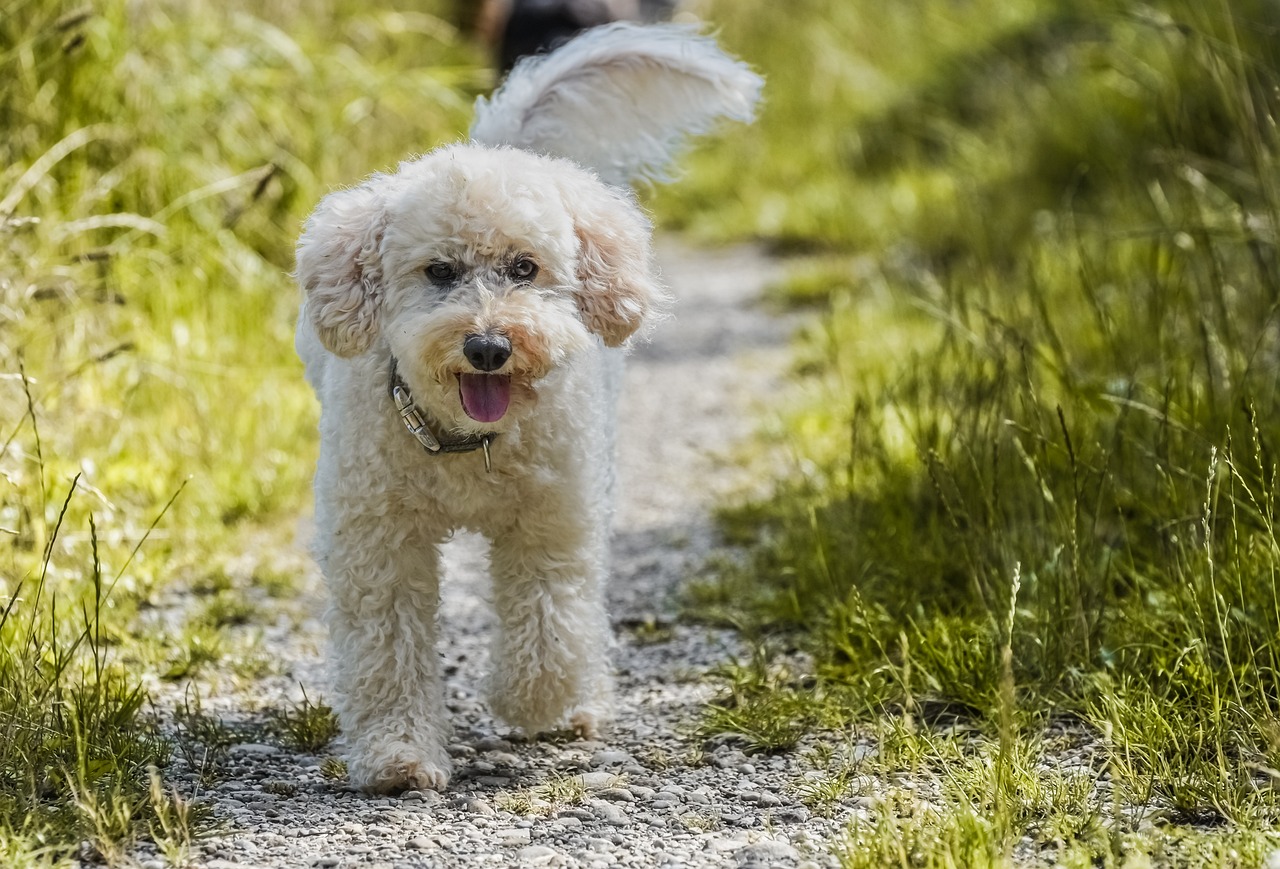
If you’re a poodle owner, you know that these intelligent and energetic dogs are a joy to be around. However, one challenge that many poodle owners face is getting their furry friend to come when called. While it may seem like a simple command, training your poodle to come when called requires patience, consistency, and some clever tricks.
In this article, we’ll explore effective strategies to train your poodle to come when called, whether you’re starting from scratch or trying to reinforce existing training. With some dedication and effort, you’ll have a well-trained poodle that always comes when called.
Note: For a complete training, we highly recommend this SpiritDog Online Training Course “Coming When Called”.
1. Start with a Strong Foundation
Before you begin training your poodle to come when called, it’s crucial to establish a strong bond with your pet. Spend time playing with your dog, engaging in activities they enjoy, and providing positive reinforcement through praise and treats. Building trust and a strong connection with your poodle will make them more likely to respond positively to your commands.
2. Choose a Distinct Command Word
Select a specific word or phrase for the recall command, such as “come” or “here.” Ensure that the command is distinct from other commands you use and that all family members use the same word consistently. Consistency is critical to avoid confusing your poodle and ensuring that they understand what you expect from them.
3. Begin Training Your Poodle in a Controlled Environment
Start training your poodle to come when called in a controlled, distraction-free environment like your home or a fenced yard. In the early stages of training, it’s essential to minimize distractions to help your dog focus on learning the new command. As your dog becomes more reliable in responding to the recall command, gradually introduce distractions and practice in various environments.
4. Use Positive Reinforcement with Your Poodle
When training your poodle to come when called, always use positive reinforcement techniques. Reward your pup with praise, treats, or playtime when they respond to your recall command. This will help create a positive association with the command and motivate your dog to respond consistently. Remember to be patient and consistent in your training, as it may take time for your dog to master the recall command.
If you’re using treats, these are currently the most popular training treats on Amazon.
5. Gradually Increase Distance and Distractions
As your poodle becomes more reliable in responding to the recall command in a controlled environment, begin to increase the distance between you and your dog during training sessions. Practice calling your dog from various distances and gradually introduce distractions, such as other dogs, people, or toys. This will help your dog learn to respond to the command even in challenging situations.
Related: Looking for the fastest way to train your poodle to come when called? Try this video course.
6. Make Yourself Interesting and Rewarding to Your Poodle
To encourage your poodle to come when called, make yourself more appealing and rewarding to your dog. Use an enthusiastic, high-pitched voice when calling your dog, and reward them with a treat or praise when they respond. You can also try running away from your dog when calling them, as this can entice your dog to chase after you and respond to the recall command.
7. Never Punish Your Poodle for Coming When Called
It’s essential to avoid punishing your poodle if they do not immediately respond to the recall command or if they come to you slowly. Punishing your dog can create a negative association with the command and make them less likely to respond in the future. Instead, be patient and continue to practice and reinforce the command using positive reinforcement techniques.
8. Practice the Recall Command Regularly with Your Poodle
Consistent practice is crucial for training your poodle to come when called. Incorporate recall training into your dog’s daily routine, and practice the command in various environments and situations. This will help reinforce the behavior and make it more reliable over time.
9. Use a Long Training Leash on Your Poodle
When transitioning from a controlled environment to a more open space, consider using a long training leash to maintain control over your poodle while they learn to respond to the recall command. This will help you avoid losing control of your dog and provide a safety measure as you gradually increase the distance and distractions during training sessions.
This is the most popular long training leash on Amazon.
10. Be Patient and Persistent with Your Poodle
Training your poodle to come when called takes time, patience, and persistence. Some dogs may learn the command quickly, while others may require more time and consistent practice. Be patient with your dog and maintain a positive attitude during training sessions. Remember that every dog is unique, and the key to success is consistent practice and positive reinforcement.
11. Use a Professional Online Poodle Training Course
While this article provides many helpful tips for training your poodle, you can increase your chances of success by enlisting the help of a professional online dog trainer. We love the SpiritDog online courses, since its includes unlimited questions with a real dog trainer.
You can check out their Teach Your Poodle to Come Online Course Here
In conclusion, training your poodle to come when called is an essential skill that will not only improve your dog’s behavior but also strengthen your bond. With the right tools, patience, and consistency, you can teach your poodle to come when called in any situation. Remember to reward good behavior, use positive reinforcement techniques, and be patient with your furry friend. With time and practice, your poodle will master the come command and become a well-behaved and obedient companion. By investing in your dog’s training, you’ll ensure a happier and healthier life for both you and your poodle.
More Frequently Asked Questions For Training Your Poodle
1. How can I train my poodle to stop barking excessively?
Poodles are known for being vocal dogs, and while some barking is natural, excessive barking can be a problem. Here are some tips to train your poodle to stop barking excessively:
- Identify the cause: Before you can effectively train your poodle to stop barking excessively, you need to identify the root cause of the barking. Is your poodle barking out of boredom, anxiety, or fear? Once you understand the cause, you can address it more effectively.
- Socialize your poodle: Socializing your poodle from a young age can help reduce anxiety and fear-related barking. Expose your poodle to new people, places, and experiences to help them feel more comfortable in different situations.
- Use positive reinforcement: When your poodle stops barking, reward them with treats, praise, or a favorite toy. This will reinforce the behavior and encourage your poodle to be quiet.
- Train a “quiet” command: Teach your poodle a “quiet” command by using a verbal cue and hand signal. When your poodle stops barking, use the command and reward them with a treat.
- Provide plenty of exercise and mental stimulation: A tired and mentally stimulated poodle is less likely to bark excessively. Make sure your poodle gets enough exercise and provide plenty of toys and puzzles to keep them mentally stimulated.
2. How can I teach my poodle to walk on a leash without pulling?
Teaching your poodle to walk on a leash without pulling requires patience, consistency, and some effective techniques. Here’s how to do it:
- Start with the right equipment: Make sure you have a well-fitting collar or harness and a sturdy leash that is the right length for your poodle.
- Use positive reinforcement: When your poodle walks calmly on a leash without pulling, reward them with treats, praise, or a favorite toy. This will encourage them to repeat the behavior.
- Practice leash walking in a distraction-free environment: Start by practicing leash walking in a quiet, distraction-free environment like your backyard. Once your poodle masters walking calmly on a leash in this setting, gradually increase the level of distraction.
- Use a gentle leader or head halter: A gentle leader or head halter can be effective tools to prevent your poodle from pulling on the leash. These devices gently guide your poodle’s head in the direction you want them to go.
- Stop and wait: When your poodle starts pulling on the leash, stop walking and wait until they stop pulling. Once they stop, continue walking and reward them for walking calmly.
- Be patient and consistent: Teaching your poodle to walk on a leash without pulling takes time and patience. Be consistent with your training and don’t give up.
3. How can I teach my poodle to be calm and relaxed in new situations?
Poodles are intelligent and adaptable dogs, but they can be prone to anxiety and stress in new situations. Here’s how to teach your poodle to be calm and relaxed in new situations:
- Socialize your poodle: Socializing your poodle from a young age is crucial for reducing anxiety and stress in new situations. Expose your poodle to new people, places, and experiences to help them feel more comfortable.
- Use positive reinforcement: When your poodle exhibits calm and relaxed behavior in new situations, reward them with treats, praise, or a favorite toy. This will encourage them to repeat the behavior.
- Teach relaxation techniques: Teach your poodle relaxation techniques like deep breathing and progressive muscle relaxation
-
4. What’s the best online course for teaching a poodle to come when called? At iHeartDogs, we recommend the SpiritDog online course “Coming When Called.” The course includes unlimited questions with a real dog trainer.
iHeartDogs is reader supported. Our articles contain affiliate links where we are paid a small commission for linking to a product at no additional cost to the reader.



 Toledo, United States.
Toledo, United States.